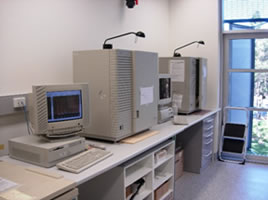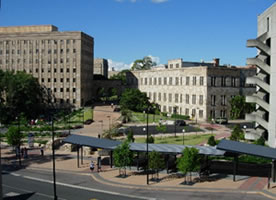I
was excited on this particular morning as I leisurely
cycled to work through the leafy streets of Brisbane,
along the river. I expected back some results that I’d
been waiting on for a while. I arrived at work, quickly
checked my e-mail, flicked through my ‘to-do’
list (I’m notoriously bad at organising myself without
lists!) and went into the lab.
Most day-to-day work in a laboratory involves pipetting
very small quantities of liquid from one location to another,
and today was no exception. This morning I had to pipette
some bacterial DNA from one tube, add it to a reaction,
then analyse the results of that reaction via computer.
The bacterial DNA samples came from a field trial that
I carried out last year on a research farm in NSW. After
calculating the appropriate reaction volumes from some
tests I had done previously, it was possible to take those
samples, and analyse them in our laboratory to provide
the information I required.
The results I was expecting back from this particular
experiment were DNA sequencing results. These DNA sequences
had the potential to provide information about the different
communities of microorganisms that I’m looking at
in my current research project.
I spent most of today switching between analysing some
of those DNA sequence results, listening to the chief
of the division present a seminar on the future of Australian
agriculture, discussing scientific papers that we’re
preparing (over coffee, obviously!), and having farewell
celebrations for a colleague who was leaving. It was a
fairly busy kind of day, but hey, it beats getting bored,
and it was Friday after all!

Setting up sequencing reactions in the lab
My
job responsibilities at the moment involve conducting novel
scientific research into a disease that affects the Australian
Merino sheep, and costs farmers a lot of money in lost revenue.
The DNA sequencing I am doing is a step towards understanding
the problem in greater detail. Initially I looked into the
problem, decided the course of research to take, and followed
that path driven by my hypothesis. Since nobody really knew
much about what actually caused the disease, this hypothesis
led me down the path of characterising which microorganisms
were involved.
After five years of working in the field (of molecular biology),
I still get extremely excited about DNA sequencing –
it really is a privilege to see things that no human eye
has ever seen before and discover new species that no one
has ever described previously. Eventually, from the project,
I am hoping to generate new knowledge that farmers can use
to better tackle the disease problem, thus putting Australia
in a stronger position on the global market.

Two of the DNA sequencers in our lab
At
high school, I did subjects in Biology, Chemistry and English
Literature, just to add a little diversity and keep my options
open. I wasn’t sure whether I’d go down the
path of biology, chemistry or a high-speed fighter pilot.
Ultimately my dreams were brought alive one day on a wet
and windy beach in northern Wales (in the UK) on a biology
field trip. I was inspired by the sea air to study marine
biology at university, which in my mind was the most exciting
of the three options.
To remain in science and work on your own research projects,
it is very beneficial to have a Ph.D. So following on from
my first degree, postgraduate study was a natural choice.
As far as the future goes, I intend to remain in science
at least for the foreseeable future. It’s a fairly
competitive field, and you certainly wouldn’t go into
it to get rich, but the daily challenge of research, the
interesting people you get to meet, and the potential to
work in a myriad of locations worldwide is hard to beat!
As testament to this, I started off life in England, where
I did my undergraduate degree, continued with a Ph.D. in
Scotland, and then came over to the fair shores of Australia
about two years ago. Science does require ongoing career
planning, and I suspect there will be many changes to my
plans in future. But, not knowing what each day will hold,
and tackling new issues are some of the things I love about
science!

The University of Queensland, where I’m based
|